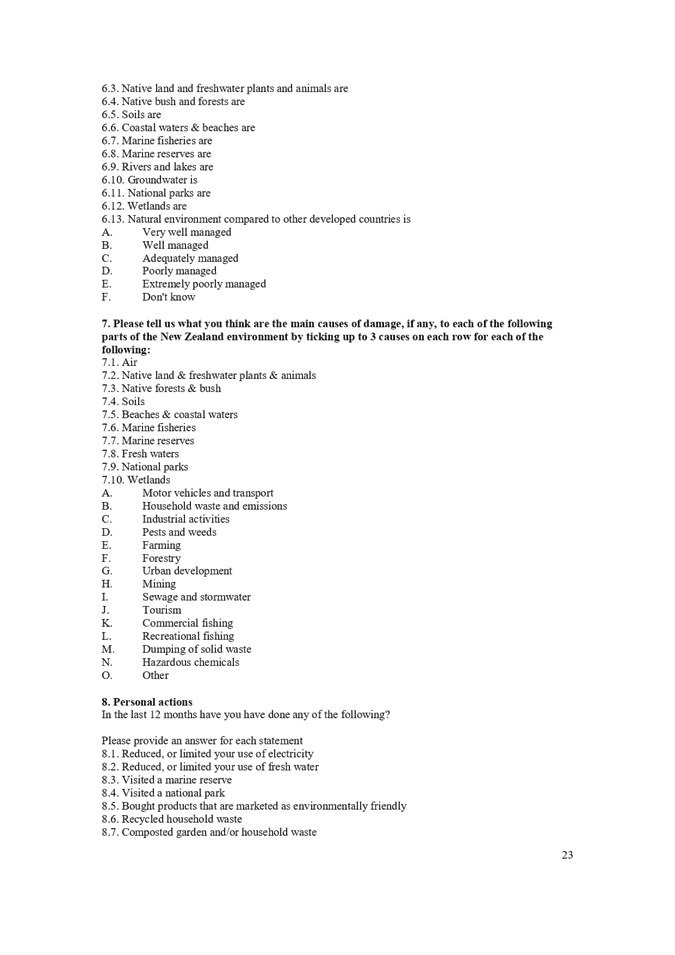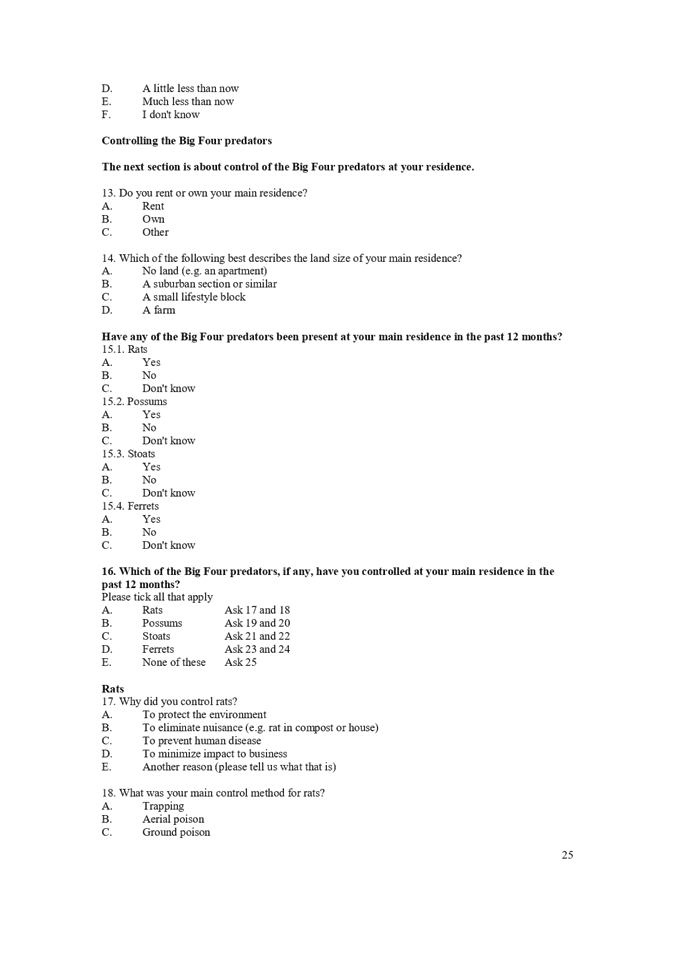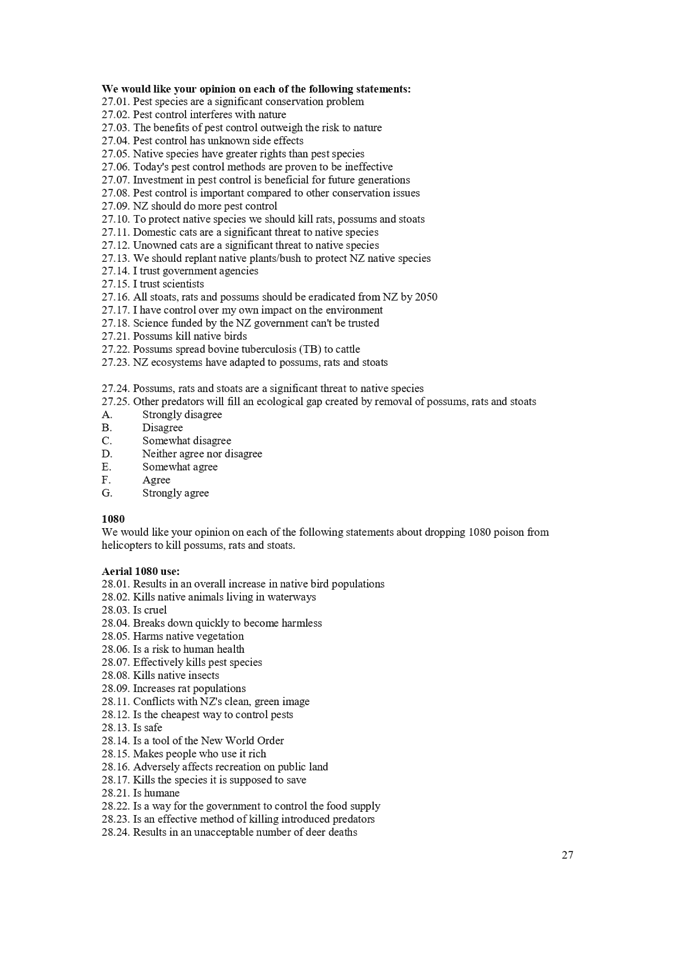HAWKE’S BAY REGIONAL COUNCIL
Environment
and Integrated Catchments Committee
Wednesday 01 July 2020
Subject: Lincoln University 2019
Survey - Public Perceptions of NZ's Environment: 2019
Reason for Report
1. This item provides the Committee with an analysis of the views
expressed by Hawke’s Bay-based participants in the 2019 Lincoln
University survey of Public Perceptions of New Zealand’s Environment.
Executive Summary
2. Lincoln University has been surveying New Zealanders’
perceptions of the State of the Environment since 2000 using a survey
questionnaire constructed around a Pressure-State-Response model. A postal
survey was undertaken biennially until 2010 and since then has been conducted
triennially and by electronic means.
3. The attached report is drawn from the results of the ninth survey
undertaken in 2019, but for Hawke’s Bay regional respondents only. The
full 2019 results for New Zealand can be found here.
4. In 2019 Council staff requested that Lincoln University provide
Hawke’s Bay specific data from its survey in order to better understand
how Hawke’s Bay residents perceive the state of the environment and the
way it is being managed. Presentation of the University’s report to
Council has been delayed by the disruption related to Covid-19 and is now
attached to this report.
5. The report suggest that overall there is a high degree of similarity
between respondents from Hawke’s Bay compared with the rest of New
Zealand in terms of their perceptions of the state of the New Zealand
environment. The respondents had similar responses to questions about levels of
knowledge about the environment, their view of the standard of living in New
Zealand, the overall state of the New Zealand environment, and on whether New
Zealand’s environment is ‘clean and green’. However, there
are some differences in the Hawke’s Bay specific responses.
6. In terms of environmental state (measured in the survey by examining
availability and quality), as with the rest of NZ, Hawke’s Bay
respondents considered the state of air and our natural environment compared to
other developed countries to be very good. Rivers and lakes rated poorest by
both sets of respondents with more people considering them to in bad or very
bad states than in good or very good.
7. In the context of management (or response) to specific environmental
issues, Hawke’s Bay respondents were particularly negative. Notably, over
60% of respondents considered farm effluent and runoff to be badly or very
badly managed – this level is around 15 percentage points more than for
the rest of New Zealand. In a consistent thread, Hawke’s Bay respondents
were particularly negative about management of rivers and lakes, and of
groundwater (nearly 50% of respondents for both reporting these resources to be
poorly or very poorly managed. Respectively the rest of New Zealand respondents
were around 40 and 30%. This finding appears unsurprising given the high
profile of freshwater management issues in Hawke’s Bay.
8. A further aspect of response examined was around pro-environment
behaviours. Hawke’s Bay respondents reported a higher level (around 15
percentage points) than the rest of New Zealand in terms of reducing or
limiting their use of freshwater, again consistent with the regional focus on
water management issues. Notably, Hawkes Bay respondents were less likely to
use public transport or to participate in natural environment restoration or
similar projects.
9. Lincoln University also explored pressures on the environment by
asking respondents to choose activities they thought were having the most
impact on each resource examined. The pattern that emerged for Hawkes Bay
largely mirrored the rest of New Zealand picture. Farming as one of the three
main causes of damage to fresh waters scored less for Hawkes Bay respondents
(37.7%) than for other New Zealand respondents (around 43%).
10. Some
caution is necessary around the representativeness of these findings, given the
relatively small sample population of 55 Hawke’s Bay residents. Lincoln
University consider that “on a population basis the sample size here is
of a similar or the same proportion to that found for other regions which were
all covered by survey. To this end we can be reasonably confident the findings
reported here are consistent with the entire survey which has a margin of error
of 3% at the 95% confidence interval.” Staff note that the Hawke’s
Bay sample, relative to the regional population, was weighted more heavily
toward females, over 50s, lower income levels, and New Zealanders of European
descent. Participation in the survey is likely to be biased toward those who
have an interest in environmental matters.
11. The
Lincoln survey does not have a focus on climate change. Council staff have
commissioned local research provider, SIL Research Limited, to undertake a
comprehensive and representative sample of Hawke’s Bay residents on
climate change issues, which will help inform the design of a community
engagement programme on climate change and associated interventions for the
2021-2031 Long Term Plan. Survey results are expected in September.
Decision Making
Process
12. Staff have assessed the requirements
of the Local Government Act 2002 in relation to this item and have concluded
that, as this report is for information only, the decision making provisions do
not apply.
|
Recommendation
That the Environment and Integrated
Catchments Committee receives and notes the “Lincoln University 2019
Survey - Public Perceptions of NZ's Environment: 2019” staff
report.
|
Authored &
Approved by:
|
James Palmer
Chief Executive
|
|
Attachment/s
|
⇩1
|
HB
Perceptions of NZ Environment Report June 2020
|
|
|
HAWKE’S BAY REGIONAL
COUNCIL
Environment
and Integrated Catchments Committee
Wednesday 01 July 2020
Subject: Heretaunga Plains Flood
Control Scheme Level of Service Review Update
Reason for Report
1. This item
provides an update to the February 2020 report where staff provided background
information and a project outline to review the current level of protection of
1 in 100 year (1 %AEP) to a new level of protection 1 in 500 year (0.2%
AEP).
Executive Summary
2. In February
2020 staff presented the Heretaunga Plains Flood Control Level of Services
project delivery plan and milestones with intention to provide Council with
regular project updates.
3. A budget of
$20M over 10 years was provisionally allocated in the 2018 LTP however through
the further work we have identified that this is unlikely to be sufficient
funding for the upgrade of the whole scheme.
4. A Project Team was established with the full time Project Manager
committed to delivering this project.
Background
5. The Heretaunga
Plains Scheme covers the low-lying historic river plains of the Tūtaekurῑ,
Ngaruroro, Clive and lower Tukituki Rivers. It provides protection against
frequent flooding to most of Hastings, Flaxmere, Havelock North and Napier
urban areas. The area directly benefiting from the Scheme covers approximately
39,000 hectares with a population of around 110,000 people living within the
scheme boundary.
6. A survey of the
general public undertaken in 2008 identified that the community consider
flooding hazard to be in the top three most important threats in Hawke’s
Bay (earthquake and tsunami being the other two). The survey also identified it
as the top issue where Council should allocate greater resources.
7. Through the
2015 LTP process, HBRC noted that Level of Services will be reviewed over time
but no further specific consultation was carried out in 2018-2028.
8. The 2018 LTP
consultation document “Facing our Future,” listed some major
infrastructure projects for next 30years. The project Heretaunga Plains Scheme
named in this document states “Improve flood carrying capacity from a 1
in 100 year event level to a 1 in 500 year level, in response to climate
change.” No further consultation with public has been carried out since
the Facing the Future document (2018-2028 Consultation document) was released.
Discussion
9. March 2020 - Presentation to Māori
Committee.
10. July 2020- Hydraulic
Modelling – will indicate what effects the protection 1 in 500 flood
event means for existing assets. 75% completed.
11. Asset Condition
Assessment - Assessing the performance of the flood protection
assets where the assessment method and frequency is aligned to risk to the
community. To date we have completed the assessment for the Tūtaekurῑ
River and assessment for remaining assets in the Scheme will follow this year
(2020). 75% completed.
12. September
2020- Refined 3 year project plan with activities
and budget expenditure for discussion with council.
13. Iwi communication
– Hui with key Iwi groups to discuss future planning and identify
significant cultural sites potentially impacted by the upgrade work.
14. December 2020- Refine
10 year plan with some high level engineering options and budgeting.
15. March 2021- Preliminary
Design and Economic Analysis – Preliminary/concept design work and
economic analysis from engineering optioneering work.
16. July- 2021- Council
Report with findings and recommendations.
Next
Steps
17. Milestone
chart attached.
Decision Making
Process
18. Staff have assessed the
requirements of the Local Government Act 2002 in relation to this item and have
concluded that, as this report is for information only, the decision making
provisions do not apply.
|
Recommendation
That the Environment and Integrated
Catchments Committee receives and notes the “Heretaunga Plains Flood
Control Scheme Level of Service Review Update” staff report.
|
Authored by:
|
Martina
Groves
Acting Regional Asset Manager
|
|
Approved by:
|
Chris Dolley
Group Manager
Asset Management
|
|
Attachment/s
|
⇩1
|
HPFCS Level
of Service Review Project
|
|
|



































